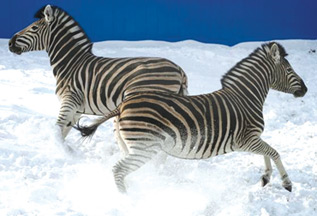Why do zebras have stripes?
Five explanations have been suggested in the past, but scientists say
a new study looking at the geographical distribution of stripes holds
the answer Scientists say that they have finally solved one of the most
intriguing mysteries of the animal kingdom: how the zebra got its
stripes.
Ever since Charles Darwin debated the topic with fellow 19th century
biologist Alfred Russel Wallace, biologists have been suggesting
possible evolutionary drivers that led to the development of these bold
black and white markings.
 Now, a team from the University of California says that they have
analysed the competing theories and concluded that the zebra's stripes
evolved over time to protect the animals from the unwanted attentions of
disease-carrying flies. Now, a team from the University of California says that they have
analysed the competing theories and concluded that the zebra's stripes
evolved over time to protect the animals from the unwanted attentions of
disease-carrying flies.
"No one knew why zebras have such striking colouration," said lead
author Tim Caro, a professor of wildlife biology. "But solving
evolutionary conundrums increases our knowledge of the natural world and
may spark greater commitment to conserving it."
Caro and his team looked at five different hypotheses, including the
possibility that the stripes were a form of camouflage, that they
confused predators or helped moderate body temperature, or even that
they were key to zebras' social interaction.
The team concluded that the stripes were a defence against
eco-parasites after looking at variations in striping patterns across
the seven living species of the equid group (the family of animals that
includes horses, donkeys and zebras) and their 20 subspecies - most of
which have striping on their body to various degrees.
They then mapped the intensity if these stripes against the various
environmental factors that might have influenced the evolution of these
markings, including the distribution of forests, predators and biting
flies.
The results show that the strongest statistical correlation is
between species of distinct stripes and areas where parasites are most
active.
"I was amazed by our results," Caro said. "Again and again, there was
greater striping on areas of the body in those parts of the world where
there was more annoyance from biting flies."
"I was delighted to see the results were so strong in one direction."
However, even this explanation does not quite close the case on zebra
stripes.
Although biologists are now fairly sure that the markings are there
to keep biting flies away, the question remains: why do these insects
avoid striped surfaces in the first place?
-The Independent
|

